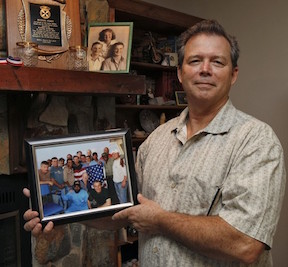Mike Perry
The heroic role of Mike Perry during the hijacking of the Maersk Alabama in 2009 was accurately portrayed in the film Captain Phillips, starring Tom Hanks.
The details of the hijack events were explained by Mike Perry, chief engineer for the Maersk Alabama, at an LDS fireside. Perry is a member of The Church of Jesus Christ of Latter-day Saints.
- His experience took place off the coast of Africa while sailing on the cargo ship. To explain why they took the risks they did, so close to Somalia, he shared that ships of this type use 30,000 to 40,000 gallons of gasoline a day, so they take all the short cuts they can.
On this day Perry was impressed to prepare in case they were attacked by these ever-present pirates in this region. He designated an armored room off the main engine room in which the crew could hide and evade capture. He secured the doors as well as he could and gathered zip ties and placed his only weapon, a pocket knife, in his pocket. No one had guns.
- The crew consisted of many new men, some who did not even speak adequate English, so these plans were a somewhat lonely endeavor. They all knew only too well that the pirates lurking in these waters would strip the ship and take the crew hostage. Ironically, the very next day, a pirate crew on a small fishing boat approached and demanded to board. This prompted Perry to pull the switch to plunge the ship into darkness.
- With the power cut off there was also no means of cooling the ship. The pirates were armed with AK-47s and following the ship closely. Perry heard the captain say he would zig zag to evade boarding but soon he heard the ominous words “the bridge is compromised.”
- Although it was totally dark, Perry was very familiar with his engine room and could find his way with little trouble. He could hear the pirates demanding their surrender and searching the ship for the crew, going to each section of the ship accompanied by Captain Phillips. It was very hot and his men were sweating and becoming ill from the heat and close quarters, but their silence was vital.
Now they were playing a deadly game of hide and seek in the pitch blackness with the stakes a lot higher than they all wanted to think about. Perry kept praying for inspiration and ideas to keep him and his men safe. Finally he realized that one of the pirates was close at hand. . . .
- He had no idea what the pirates looked like, or how big they were. He counted his steps in which he moved in his engine room; he could hear them closing in. Suddenly there was a blinding light from the pirate’s flashlight and Perry launched himself at the pirate and held his pocket knife at his throat. He called for help from his engine room crew and instead of just holding the pirate, they were about to murder him, but Perry restrained them.
- Ultimately, they decided to trade the pirate leader for the captain who was taken hostage. Instead of honoring the terms of agreement, they took off with the pirate hostage and the captain in the small fishing boat. It was left to the Navy and the Navy Seals to dispatch the pirates and take the leader into custody and rescue Captain Phillips. The pirate leader. Abduwali Muse, was later tried and sentenced to 33 years in prison.
- “This crew battled for 33 hours with the pirates,” Perry said. “Everyone in the crew was a hero.”[1]
Perry, who spent 45 years on the sea, became a merchant marine after retiring from the US Navy as a lieutenant commander. He retired from his sea-going career, and he and his wife Hannah are now living in Tampa, Florida.
Perry told the press, “I didn't pattern myself after Chuck Norris or Jackie Chan,” referring to his actions on the ship. “The only thing that got me ready for this was the gospel of Jesus Christ.”[2]
